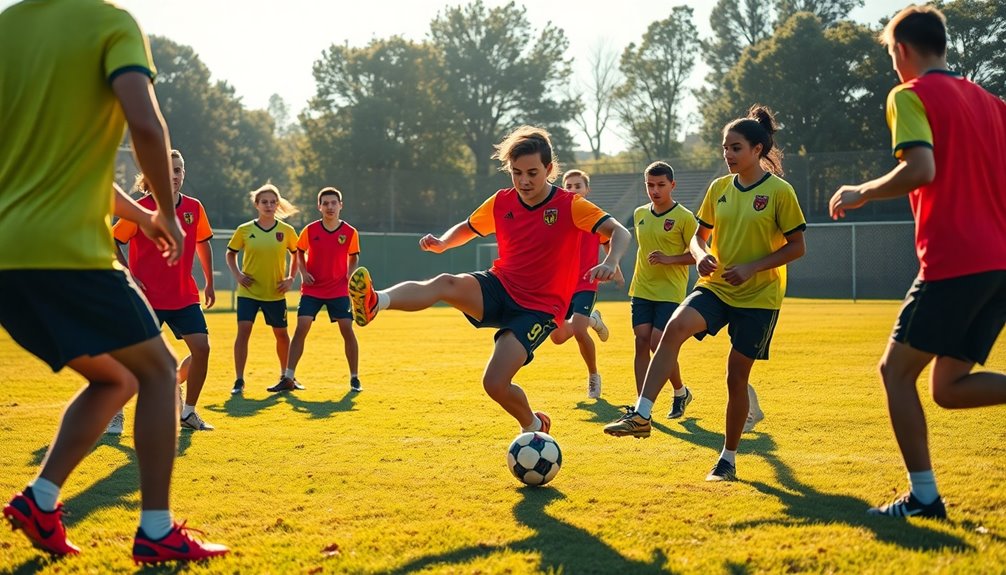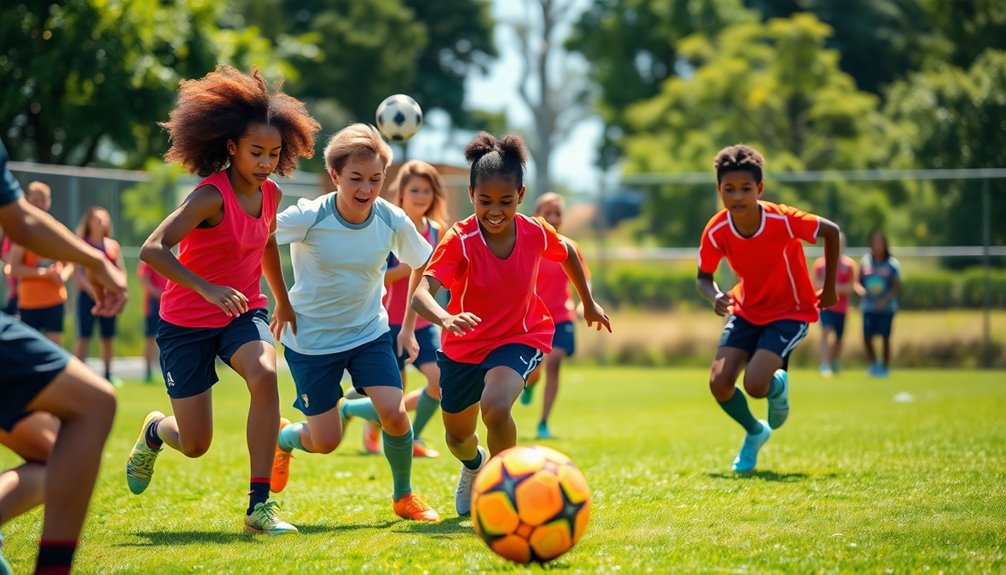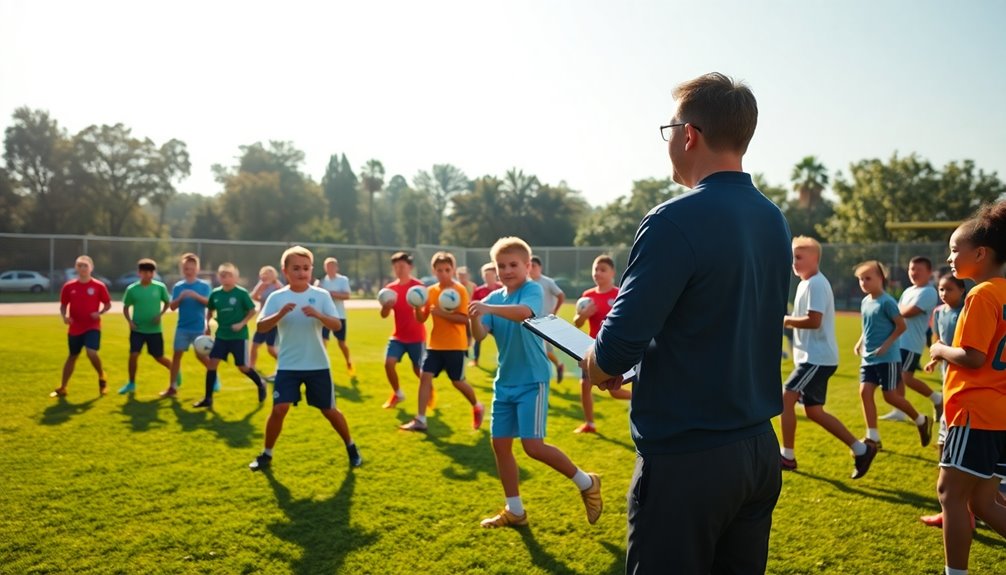
Passing Drills to Build Strong Team Dynamics
February 3, 2025To build strong team dynamics, incorporate passing drills that emphasize communication and cooperation. Drills like Triangle Passing and Rondo enhance your understanding of teammates' movements, improving both passing accuracy and cohesion on the field. You'll develop clean techniques, spatial awareness, and quick decision-making while fostering trust and camaraderie. Passing Relay Races and Square Drills can further motivate players to work together, reinforcing dialogue and collaboration. As you practice and measure success through performance metrics, your team's connection strengthens. Stick around to discover more drills that can elevate your team's synergy and effectiveness game after game.
Importance of Passing Drills
Passing drills are fundamental for fostering teamwork and enhancing communication on the field. When you engage in these drills, you learn to understand your teammates' movements and intentions, which is essential for developing cohesive team dynamics. Effective passing is critical for maintaining possession, and studies show that teams with higher passing accuracy often perform better in matches. Incorporating teamwork enhancement exercises helps create a more unified playing style, further improving overall performance.
As you practice passing drills, you'll notice an improvement in your passing skills and your ability to make quick decisions under pressure. This repetition builds muscle memory, allowing you to execute accurate passes instinctively during competitive play, boosting your confidence. Incorporating quality training sessions into your routine ensures that your practice remains effective and purposeful.
Additionally, participating in passing drills fosters camaraderie among teammates. When you work together toward a common goal, trust develops, creating a solid foundation for a successful team. The more you practice, the more comfortable you'll feel with each other, which translates into better communication during games. Engaging in these drills also enhances your ability to identify open teammates and capitalize on passing lanes.
In short, regular passing drills not only improve your technical skills but also enhance teamwork and communication, leading to a more harmonious and effective team on the field. Embrace these drills, and watch your team dynamics flourish!
Effective Passing Techniques
Mastering effective passing techniques is vital for any player looking to elevate their game. By focusing on key elements, you'll enhance your passing accuracy and overall performance on the field.
Here are four significant techniques to incorporate:
- Clean Contact: Guarantee precise foot placement and body posture when striking the ball. This assures clean contact, improving your passing precision. Additionally, understanding the importance of anticipation of opponent movements can further enhance your passing strategy.
- Dominant and Non-Dominant Feet: Train yourself to use both feet. This versatility allows you to adapt to various passing situations, making you a more dynamic player.
- One-Touch Passing and Triangle Passing: Implement one-touch passing drills, like the Triangle Passing drill, to boost quick decision-making and fluid team communication. Anticipate your teammates' movements to maintain the flow of play.
- Spatial Awareness: Engage in dynamic drills to enhance your spatial awareness. This skill will help you identify passing opportunities and distribute the ball effectively under pressure. Additionally, practicing step-over skills can further improve your ability to maneuver and create space for effective passes.
Team Building Through Drills

Building strong team dynamics is just as important as mastering individual skills like passing techniques. Incorporating passing drills such as Triangle Passing fosters communication and understanding among players, enhancing your ability to anticipate each other's movements on the field. Regular practice of these drills is essential for developing technical skills that can lead to improved team performance.
When you engage in competitive drills like Passing Relay Races, you'll notice how collaboration builds camaraderie, as you rely on your teammates' skills to succeed.
Rondo drills, particularly the 4 vs 1 format, sharpen your passing under pressure, promoting quick decision-making and trust among teammates. You'll learn to work together to maintain possession, reinforcing that unity is key.
Square Passing Drills emphasize spatial awareness and positioning, allowing you to develop a sense of team dynamics as you navigate structured spaces effectively.
Regular practice of Dynamic Movement Drills helps you coordinate your movements and passing patterns, leading to improved chemistry on the field. Additionally, understanding the principle of team coordination is essential for synchronized movements during drills.
As you continue to practice these drills, you'll observe how your team evolves, becoming more cohesive and efficient in gameplay. Ultimately, these drills not only enhance your skills but also strengthen the bonds that make your team successful.
Drills for Enhanced Communication
Enhancing communication on the field can considerably elevate your team's performance during drills. By focusing on effective passing and receiving, you can improve your communication among players, which is essential for success.
Here are four drills to boost your team's communication skills:
- Triangle Passing: This drill emphasizes quick passing and helps players understand teammates' movements and positioning, enhancing spatial awareness. This understanding is crucial for a defending midfielder who needs to anticipate both offensive and defensive plays. Additionally, mastering defensive stance allows players to maintain balance and readiness while executing passes.
- 4 vs 1 Rondo: In this drill, players must use verbal and non-verbal cues to call for the ball and anticipate their teammates' movements under pressure, fostering teamwork.
- Square Drill: Encouraging players to talk to each other, this drill promotes passing accuracy while helping them maintain possession and navigate passing options.
- Scoring Systems: Implementing a scoring system in your drills motivates players to communicate effectively, working together to achieve shared objectives.
Additionally, understanding defensive player roles can help players communicate better during these drills, as they become more aware of their teammates' responsibilities on the field.
Incorporating constructive feedback during these drills reinforces the importance of clear communication. As players trust one another and develop a cohesive understanding of each other's playing styles, your team will become more dynamic and efficient on the field.
Adapting Drills for Different Levels

When it comes to adapting drills for different skill levels, understanding your players' unique abilities is essential. Start by evaluating their current passing skills to tailor drills that meet their needs. For beginners, introduce simple passing drills like Wall Passing or Circle Passing. Incorporating basic dribbling techniques can also enhance their overall ball control. To further support their development, consider integrating soccer control moves that emphasize balance and coordination.
As they develop their soccer skills, increase the complexity with Triangle Passing or Rondo drills to enhance ball control and decision-making. Utilizing differentiated instruction can greatly benefit your practice. Adjust the size of the playing area or the number of touches allowed to challenge advanced players while keeping it manageable for novices. Peer pairing is another effective strategy; pairing experienced players with beginners fosters mentorship and encourages skill development through observation and guidance. Ensure to provide real-time feedback during these drills. Focus on both the strengths and areas for improvement, helping players at all levels grasp the tactical aspects of passing. Additionally, practicing accurate passing is crucial for setting up scoring opportunities in games.
Measuring Success in Drills
When measuring success in passing drills, you'll want to focus on performance metrics that highlight your team's strengths and weaknesses. Tracking skill progress and team cohesion helps you understand how well your players are communicating and adapting during practice. Additionally, effective teamwork, which involves communication, trust, and role understanding, is crucial for maximizing the benefits of these drills. Incorporating endurance training methods into your practice can also enhance overall team performance by ensuring players maintain high energy levels throughout the drills.
Performance Metrics Evaluation
Measuring success in passing drills is vital for understanding player and team development. To effectively appraise performance metrics, focus on these key areas:
- Accuracy Rates: Track the percentage of successful passes, aiming for at least 70-80% to guarantee effectiveness in drills.
- Completed Passes: Monitor the number of completed passes per session. Aim to increase this number by 10% over a set period to boost player improvement and team cohesion.
- Decision-Making Speed: Measure the time taken to complete passing sequences. Aim to reduce this time by 15-20% as players grow more accustomed to the drills.
- Turnovers: Keep an eye on turnover rates during practice sessions, aiming to maintain this below 10% for peak team performance.
Utilizing video analysis is vital for evaluating spatial awareness and player positioning. This allows you to pinpoint areas for improvement that can lead to better performance on game days.
Skill Progress Tracking
Tracking skill progress in passing drills is essential for fostering player development and team success. By regularly evaluating players' performance, you can track metrics like passing accuracy percentage and successful one-touch passes to gauge improvement over time.
Implement a scoring system during drills that rewards accuracy and creative plays, which helps encourage players to focus on their skills while creating a competitive atmosphere.
Utilizing visual analysis tools allows players to review their passing techniques and decision-making processes. This visualization fosters clear communication and targeted feedback, enabling more significant growth.
Maintain thorough documentation of both individual and team progress to identify areas for improvement and reinforce successful practices.
Conduct periodic evaluations with players to discuss their self-evaluations. This promotes a sense of ownership over their skill progress tracking and encourages open dialogue about areas for improvement.
By actively engaging with players in this way, you can help them recognize their strengths and weaknesses, ultimately empowering them to take charge of their development.
With consistent tracking and feedback, you'll cultivate a culture of improvement that benefits the entire team.
Team Cohesion Assessment
To gauge team cohesion effectively, focus on the success rate of completed passes during drills, aiming for a completion rate above 75%. This metric directly reflects how well your players are working together.
Here are key factors to evaluate:
- Successful Passes: Track the percentage of completed passes to measure team performance.
- Communication Levels: Observe players calling for the ball or providing feedback, indicating strong team dynamics.
- Players' Positioning: Evaluate how players adapt their positioning based on teammates' movements, showcasing their understanding of team strategy.
- Passing Accuracy & Decision-Making: Monitor improvements in accuracy and decision-making under pressure over time to quantify synergy.
Additionally, conducting post-drill reflections allows players to share their experiences and insights. This dialogue can help identify areas of success and pinpoint opportunities to enhance overall team cohesion.
By consistently evaluating these elements during passing drills, you'll foster a stronger, more unified team that thrives on effective communication and strategic collaboration.
Conclusion
In the grand tapestry of teamwork, passing drills weave the threads of communication and trust. By honing effective techniques and adapting exercises for all skill levels, you're nurturing a cohesive unit ready to tackle any challenge. As you measure success, remember that each drill is a stepping stone, propelling your team toward greater heights. Embrace the journey, and watch as your squad transforms into a well-oiled machine, dancing seamlessly across the field with purpose and unity.


